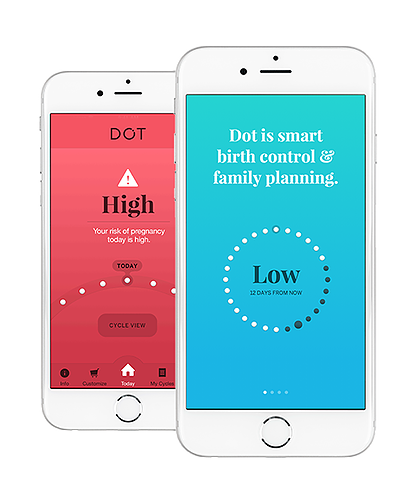How the Rhythm Method Is Changing the Way People Think About Birth Control

By:
Birth control? There's an app for that.
The rhythm method, a birth control method developed in the 1920s and officially named in 1932, is getting a technological makeover. Now you can use your phone to access apps that can help you utilize this method.
ATTN: spoke with Dr. Jerilynn Prior, founder and Scientific Director of the Centre for Menstrual Cycle and Ovulation Research about these apps and fertility tracking. "I think [they're] often very helpful," she said. "I can't speak in general for apps, because some of them are quite good and user friendly and helpful, and some are not. So I think each woman needs to do some checking herself."
What is the rhythm method?
First, let's be clear about what the rhythm method is not. It is not the pull-out method (AKA withdrawal method). Pulling out is when, during heterosexual sex, the man does not ejaculate inside the woman. Instead he, you know, pulls out before ejaculation.
The Rhythm method, AKA periodic abstinence, is when a couple has unprotected sex during times when the woman is at her least fertile.
She knows when this will be because the method requires that she (or both of them, hell, it's 2016) track her menstrual cycle to determine which days should be avoided.
Similar to the rhythm method is a fertility awareness-based method (FAM).
Prior describes the rhythm method as, "the most primitive [fertility awareness method], if you will. But the fertility awareness methods are much safer and much more accurate."
The biggest difference between a FAM method and the rhythm method is that with a FAM, you're measuring mucus levels produced by your cervix when your estrogen levels are high, and/or your taking your temperature. Another difference, according to Prior, is "the training. Those people who advocate and use FAM realize that women need some assistance and practice and support and all the rest of it [to use it properly]." You kind of have to do your homework with this method.
You may have seen movies or television shows where a couple is trying to get pregnant, and the woman will run into a beautifully stylish living room, holding a thermometer, and say something like, "Honey, I'm ovulating!" That's basically the rhythm method working to make a baby, instead of preventing one.
How is it done?
There are apps that help you track your fertility to determine which days you can have sex without getting pregnant. Prior also offers a free menstrual cycle calendar or diary for download, if you're less inclined to leaving fertility tracking to an app. Tracking your fertility is "helpful because you learn something about yourself," Prior explains. She also provides an ovulation tracker using their Quantitative Basal temperature tool.
For the technologically savvy, one such app is Natural Cycles, which requires in-app purchases and a thermometer. The app comes with a free trial but after that it's $8.99 per month or $64.99 per year to use. Here's a basic rundown: After waking up in the morning, you take your temperature with a thermometer (sorry, the app can't do that) and the app shows you if it is a "red day" or a "green day."
 NaturalCycles/Apple
NaturalCycles/Apple
If it is a red day, you're at "peak fertility"; if it's green, you aren't. It detects when you're ovulating, when you're going to get your period, and even when you're pregnant. You take and record your temperature because it helps track your ovulation and detect your fertility more accurately. Your body temperature rises when you're less fertile. And "by tracking your temperature every morning, you will know when ovulation occurs regardless of the regularity of your cycles," according to Natural Cycles.
 Natural Cycles Blog - naturalcycles.com
Natural Cycles Blog - naturalcycles.com
The app works because it uses simple science. "A woman is fertile up to 6 days per cycle," Natural Cycles explains. "The fertile window ends with the day of ovulation and begins up to 5 days before, depending on sperm survival. Natural Cycles carefully studies your body temperature to find your ovulation day and fertility."
Other apps are DOT, which bills itself as, "The Smart & Scientific Way to Plan Pregnancy, Prevent Pregnancy, and Predict Future Period Dates." There is no charge to use DOT because, according to their site, "we believe that family planning options should be free." There is a Dot Pro available for purchase which offers added "nifty" features.
 DOT App - dottheapp.com
DOT App - dottheapp.com
And to go beyond just an app, there's Daysy, which combines a thermometer with an electronic fertility tracker.
But to do it the old fashioned way, you need a calendar and the ability to do simple math.
The Mayo Clinic explains how. Get a calendar and write down the number of days your period lasts, counting from the first day of your period to the first day of the following period. Figure out what the shortest number of days is in your menstrual cycle, then subtract 18 to get the first fertile day in your cycle.
Example:
"If your shortest cycle is 26 days long, subtract 18 from 26 — which equals 8. In this example, the first day of your cycle is the first day of menstrual bleeding and the eighth day of your cycle is the first fertile day." — Mayo Clinic.
Then, do the same thing to figure out the last fertile day in your cycle by tracking your longest menstrual cycle, but subtract 11 instead of 18.
Example:
"If your longest cycle is 32 days long, subtract 11 from 32 — which equals 21. In this example, the first day of your cycle is the first day of menstrual bleeding and the 21st day of your cycle is the last fertile day." — Mayo Clinic.
From there, plan to avoid sex on the days when you're most fertile each month. And don't forget to track your menstrual cycles every month so you can update accordingly, to ensure you're always getting down on the right days.
 Planned Parenthood/plannedparenthood.org - plannedparenthood.org
Planned Parenthood/plannedparenthood.org - plannedparenthood.org
Basically, apps like Natural Cycle make this whole system easier to use, are more FAM than the straight-up rhythm method.
What is the rate of failure?
When asked if a FAM is a risky birth control option, Prior said, "It's certainly less risky than the rhythm method. About 11 out of 100 women using the rhythm method alone will get pregnant in a given year. So that's the risk of pregnancy with just rhythm alone."
Dr. Nathaniel DeNicola, an OBGYN with the University of Pennsylvania Health System, told CNN, "You hear about 25 percent, 1 in 4, who use it correctly can expect to get to get pregnant." The CDC places FAM under "least effective" though the CDC does not clarify whether this is the rhythm method or a more scientifically based FAM.
But Raoul Scherwitzl and Elina Berglund, the scientists who created Natural Cycles, boast a 99.95 percent rate of effectiveness for their app, according to VICE, who interviewed the doctors. "It's like any birth control," Scherwitzl told VICE. "You have the perfect use, and then you have the typical use." He notes that their app tries to adjust to the user if she forgets to track her stats. "The nice thing with us is if you forget to record, that's okay. The algorithm will become more and more skeptical and will say, 'Like okay, this day, even though it could have been a green day, you [didn't pay attention].'"
Why do people use the rhythm method or FAM?
Aside from the perks of it being free, it doesn't mess with hormones.
"Basically, we provide a hormone-free birth control method," Scherwitzl says of his app. "You get to know your body, rather than doing something to it."
One Redditor shared in Reddit's "Ask Women" community why she uses FAM:
"I developed an intolerance to birth control hormones (if triggering a case of the full-blown Crazies can be called an intolerance), and I'm stupid sensitive to latex and spermicide. My partner and I talked about it, and we decided that FAM was the best option for us."
Rachel, a woman from Arizona, told The Atlantic that she's used fertility-awareness methods for almost 10 years, and that "it's brought [my husband and I] closer than ever because he's so in tune with my body and my natural cycles."
It seems like there's a rise in FAM as a contraception method. Prior agrees. "It makes a lot of sense. And women are seeking for non-hormonal contraception, and I completely agree with that."
